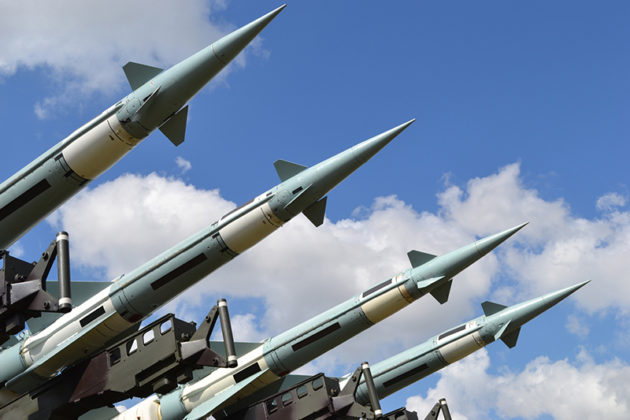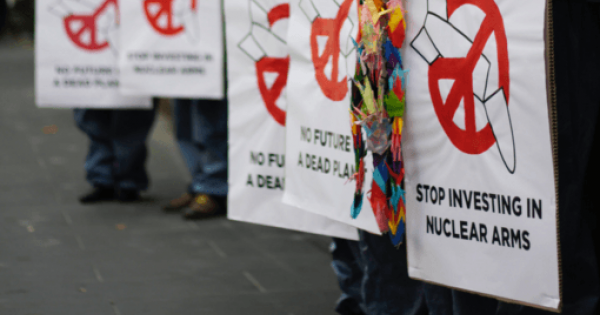
STRATCOM Commander Says
Nuclear Modernization Is the ’Absolute Minimum’
Greg Hadley / Air Force Magazine
(March 8, 2022) — Modernizing the nuclear triad and its accompanying systems isn’t just necessary for the US to deter adversaries — nuclear modernization is the “absolute minimum” that has to be done, the head of US Strategic Command told a Senate panel March 8.
Adm. Charles “Chas” A. Richard has been sounding the alarm on China’s nuclear progress for months, saying the Chinese experienced a “strategic breakout” after reports emerged that it had significantly expanded its nuclear infrastructure.
Now, with Russia’s invasion of Ukraine and President Vladimir Putin’s decision to put Russia’s nuclear forces on high alert, tensions are higher than ever, and modernization should be just the start, Richard told the Senate Armed Services Committee.
“It is very clear that the absolute minimum that we need to do is to recapitalize the triad, the nuclear command and control, and the nuclear weapons complex,” Richard said. “But there’s two other questions we need to be asking ourselves along the way with that. The threats are changing in a way that we have not seen in 30 years. We do not know the endpoints of where either of those other two are going, either in capability or capacity. We’re just now starting to work out what three-party stability looks like, what three-party deterrence dynamics works out.
“On top of that, we are learning a number of lessons in real time on how actual crisis deterrence works. It is different from the steady-state deterrence that most of us have experience in. Those two questions, I think, need to be asked much more frequently than we have needed to in the past, followed with, what is the capability, capacity, and posture we require from our strategic forces moving forward?”
Those are questions, Richard said, that STRATCOM has been working on, along with others that many analysts are now considering, such as: How would the US respond if Putin were to use a low-yield nuclear weapon in Ukraine?
“We have rewritten deterrence dynamics theory over the years. We have new analysis that we’re using,” Richard said. “We got criticized for that. We got told that it was highly improbable or somehow self-serving for us to think our way through this, but we ignored that, such that to this point, nothing has happened that we didn’t anticipate, we hadn’t thought about, and hadn’t prepared for.”
For the most part, Richard’s argument for modernization was received favorably by the Senate panel. But he did receive some pushback from Sen. Elizabeth Warren (D-Mass.), who questioned why the Pentagon did not consult with outside experts on the feasibility of extending the Minuteman III intercontinental ballistic missile system instead of buying the new Ground Based Strategic Deterrent.
“It appears DOD simply didn’t want to do a study that might show a massively expensive nuclear spending program wasn’t actually necessary,” Warren said, adding that she believed the role of nuclear weapons should be minimized.

“I look forward to the Nuclear Posture Review being published so you can see exactly how and what it concluded,” Richard responded. “But I will add, thank goodness we have ICBMs right now. I’ll explain more in closed testimony.”
It’s not only nuclear weapons that need to be modernized, Richard said. The bomber fleet, and the aerial refueling fleet that supports it, are also set to undergo major changes in the near future, as the B-21 Raider comes online, the B-52 receives new engines, the number of KC-46s grows, and the Air Force pursues its “bridge tanker.”
As these new changes come, they carry implications for STRATCOM. One challenge, in particular, is the threat of electromagnetic pulses. Sen. Tim Kaine (D-Va.) asked Richard how STRATCOM’s need for EMP-hardened airframes was being met.
“I have certain requirements, EMP protection … being one of those. So one is to clearly articulate the requirements. Two is go see what we can do in terms of employment of our force to reduce that demand signal [for tankers],” Richard said.
“A great example I can point to, and I would give credit to the Air Force, is the re-engining of the B-52s. The engines on those date back to the 60s. They burn a lot of gas. [To] re-engine, less fuel [is] required, less tanker demand. And then what other efficiencies can we achieve, while still maintaining the flexibility and the signaling capability of the air leg, which is one of its prized attributes?”
Thanks to Jay Coghlan, Executive Director Nuclear Watch New Mexico, 903 W. Alameda #325, Santa Fe, NM 87501 for forwarding this article.
Posted in accordance with Title 17, Section 107, US Code, for noncommercial, educational purposes.